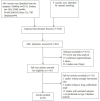Association between organic cation transporter genetic polymorphisms and metformin response and intolerance in T2DM individuals: a systematic review and meta-analysis
- PMID: 37546319
- PMCID: PMC10400771
- DOI: 10.3389/fpubh.2023.1183879
Association between organic cation transporter genetic polymorphisms and metformin response and intolerance in T2DM individuals: a systematic review and meta-analysis
Abstract
Background: Variants in organic cation transporter (OCT) genes play a crucial role in metformin pharmacokinetics and are critical for diabetes treatment. However, studies investigating the effect of OCT genetic polymorphisms on metformin response have reported inconsistent results. This review and meta-analysis aimed to evaluate the associations between OCT genetic polymorphisms and metformin response and intolerance in individuals with type 2 diabetes mellitus (T2DM).
Method: A systematic search was conducted on PubMed, EMBASE, CNKI, WANFANG DATA, and VIP database for identifying potential studies up to 10 November 2022. The Q-Genie tool was used to evaluate the quality of included studies. Pooled odds ratios (OR) or standardized mean differences (SMD) and 95% confidence intervals (95% CI) were calculated to determine the associations between OCT genetic polymorphisms and metformin response and intolerance that were reflected by glycemic response indexes, such as glycated hemoglobin level (HbA1c%) or change in glycated hemoglobin level (ΔHbA1c%), fasting plasma level (FPG) or change in fasting plasma glucose level (ΔFPG), the effectiveness rate of metformin treatment, and the rate of metformin intolerance. A qualitative review was performed for the variants identified just in one study and those that could not undergo pooling analysis.
Results: A total of 30 related eligible studies about OCT genes (SLC22A1, SLC22A2, and SLC22A3) and metformin pharmacogenetics were identified, and 14, 3, and 6 single nucleotide polymorphisms (SNPs) in SLC22A1, SLC22A2, and SLC22A3, respectively, were investigated. Meta-analysis showed that the SLC22A1 rs622342 polymorphism was associated with a reduction in HbA1c level (AA vs. AC: SMD [95% CI] = -0.45 [-0.73--0.18]; p = 0.001). The GG genotype of the SLC22A1 rs628031 polymorphism was associated with a reduction in FPG level (GG vs. AA: SMD [95 %CI] = -0.60 [-1.04-0.16], p = 0.007; GG vs. AG: -0.45 [-0.67-0.20], p < 0.001). No statistical association was found between the remaining variants and metformin response and intolerance.
Conclusion: SLC22A1 rs622342 and rs628031 polymorphisms were potentially associated with glycemic response to metformin. This evidence may provide novel insight into gene-oriented personalized medicine for diabetes.
Keywords: genetic polymorphisms; metformin intolerance; metformin response; organic cation transporters; type 2 diabetes mellitus.
Copyright © 2023 Peng, Gong, Xu, Liang, Chen, Hong and Yan.
Conflict of interest statement
The authors declare that the research was conducted in the absence of any commercial or financial relationships that could be construed as a potential conflict of interest.
Figures


Similar articles
-
Genetic Variants of SLC22A1 rs628031 and rs622342 and Glycemic Control in T2DM Patients from Northern Mexico.Genes (Basel). 2025 Jan 24;16(2):139. doi: 10.3390/genes16020139. Genes (Basel). 2025. PMID: 40004467 Free PMC article.
-
Altered Glycemic Control Associated With Polymorphisms in the SLC22A1 (OCT1) Gene in a Mexican Population With Type 2 Diabetes Mellitus Treated With Metformin: A Cohort Study.J Clin Pharmacol. 2019 Oct;59(10):1384-1390. doi: 10.1002/jcph.1425. Epub 2019 Apr 23. J Clin Pharmacol. 2019. PMID: 31012983
-
Influence of SLC22A1 rs622342 genetic polymorphism on metformin response in South Indian type 2 diabetes mellitus patients.Clin Exp Med. 2015 Nov;15(4):511-7. doi: 10.1007/s10238-014-0322-5. Epub 2014 Dec 10. Clin Exp Med. 2015. PMID: 25492374
-
Influence of Solute Carrier Family 22 Member 1 (SLC22A1) Gene Polymorphism on Metformin Pharmacokinetics and HbA1c Levels: A Systematic Review.Curr Diabetes Rev. 2024;20(4):e070823219470. doi: 10.2174/1573399820666230807145202. Curr Diabetes Rev. 2024. PMID: 37550919
-
Association of the SLC47A1 Gene Variant With Responses to Metformin Monotherapy in Drug-naive Patients With Type 2 Diabetes.J Clin Endocrinol Metab. 2022 Aug 18;107(9):2684-2690. doi: 10.1210/clinem/dgac333. J Clin Endocrinol Metab. 2022. PMID: 35639991
Cited by
-
Influence of OCT2 gene variants on metformin efficacy in type 2 diabetes: insights into pharmacogenomics and drug interactions.J Transl Med. 2025 Aug 7;23(1):884. doi: 10.1186/s12967-025-06720-y. J Transl Med. 2025. PMID: 40775340 Free PMC article. Review.
-
Genetic diversity of variants involved in drug response among Tunisian and Italian populations toward personalized medicine.Sci Rep. 2024 Mar 10;14(1):5842. doi: 10.1038/s41598-024-55239-7. Sci Rep. 2024. PMID: 38462643 Free PMC article.
-
Advancements in precision medicine: multi-omics approach for tailored metformin treatment in type 2 diabetes.Front Pharmacol. 2024 Nov 28;15:1506767. doi: 10.3389/fphar.2024.1506767. eCollection 2024. Front Pharmacol. 2024. PMID: 39669200 Free PMC article. Review.
-
Genetic Variants of SLC22A1 rs628031 and rs622342 and Glycemic Control in T2DM Patients from Northern Mexico.Genes (Basel). 2025 Jan 24;16(2):139. doi: 10.3390/genes16020139. Genes (Basel). 2025. PMID: 40004467 Free PMC article.
-
View on Metformin: Antidiabetic and Pleiotropic Effects, Pharmacokinetics, Side Effects, and Sex-Related Differences.Pharmaceuticals (Basel). 2024 Apr 8;17(4):478. doi: 10.3390/ph17040478. Pharmaceuticals (Basel). 2024. PMID: 38675438 Free PMC article. Review.
References
Publication types
MeSH terms
Substances
LinkOut - more resources
Full Text Sources
Medical

